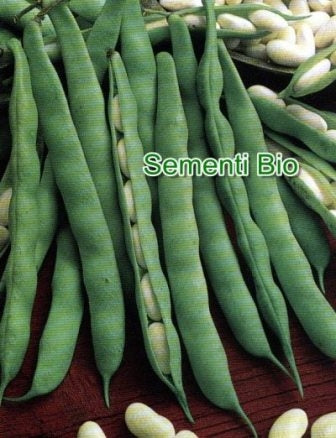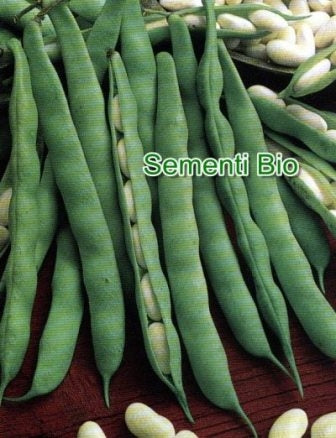Scientific name: Phaseolus Vulgaris
Family: Fabaceae
Brief history and botanical notes on the plant
There are numerous species of grain legumes which are very different in botany and origin and are ascribed to the Phaseolus genus, all indicated with the term beans. The bean par excellence is the common bean or Phaseolus vulgaris L.
In the world, over 25 million hectares are cultivated for the production of dry beans, for a total of 18 million tonnes; among grain legumes, beans are in 2nd place in importance at a global level, after soy.
The common bean (Phaseolus vulgaris L.) originates from South America (Peru, Colombia). It is widespread especially in Asia, but in the Mediterranean basin. In Europe the largest producer is Spain, followed by Portugal, Italy and Greece.
It is a rapidly developing annual plant, with a very branched and rather superficial root system, of very variable height and habit, from dwarf to climbers. Dwarf beans are best suited to open field cultivation. Creepers lend themselves well to cultivation in vegetable gardens where harvesting is gradual and manual.
The first leaves are simple, the others trifoliate with heart-shaped leaves. The flowers are gathered in clusters ranging from 4 to 10 in the axils of the leaves, and are mostly pinkish white in colour. The flowering is cleistogamous, which determines a strict autogamy, so the variety is identified with the pure line. The fruit is a pendulous, multi-seeded legume of very variable shape, color and size: compressed or cylindrical, green or yellow, 60 to 220 mm long, straight or curved. An important anatomical character is the presence or absence of fibrous tissues in the pod which determines the type of use. There are thus two types of pod structure:
– Pods whose valves separate easily due to the presence of a fibrous cord along the welding lines (“thread”) and have layers of fibrous tissue (“parchment”) within each valve: their use is for seed;
– Pods without string and without parchment and which are therefore tender and fleshy for a long time (eating beans or croissant beans, more commonly called “green beans”).
The size, shape and color of the seeds are incredibly variable. The shape varies from sphere, to parallelepiped, to kidney-shaped, to oval, to flattened, to cylindrical.
The colors are very different: from white to black passing through yellow, beige, brown, pink, red, violet; the color can be uniform or variegated.

Environmental needs
The bean is demanding when it comes to heat. The minimum temperature for acceptably prompt and regular births is 13-14°C.
The bean suffers greatly from drops in temperature: it dies at 1-2 °C. for these reasons in temperate zones the bean can only be grown in the spring-summer or summer period.
The bean is very afraid of drought: in this case the plant withers during the hottest hours, the pods abort or contain few seeds, the seeds do not reach full development.
Taking into account these facts and the limited depth of the root system, in the Italian climate irrigation is generally necessary to achieve satisfactory and constant production. Ripening is favored by dry weather.
The most suitable soil for beans is loose, fresh, fertile, it must not be too calcareous, otherwise the seeds obtained are hard and difficult to cook due to the thickening of the seed coat.
The bean adapts to heavy soils, as long as these are not subject to forming crust because this is a very serious obstacle to the birth of the seedlings, whose germination is, as has been said, epigeal and whose cotyledons are subject to breaking at the slightest obstacle in the phase of the emergency.
The bean has a very strong intolerance for salinity.
Variety
The enormous genetic variability of the species and the strict autogamy that characterizes its floral biology have meant that in the past centuries countless varieties have been isolated, equipped with adaptation to local conditions but above all with morphological and organoleptic characteristics appreciated by consumers.
Cultivation technique
Soil rotation and preparation
Given the brevity of the crop cycle, the bean fits well into certain crop systems as an intercrop crop.
The preparation of the soil in the case of spring sowing in the main crop involves a main tillage at medium depth prior to sowing. The hydraulic arrangement of the fields must be taken care of because the bean finds it very difficult to be born and grow on cold and humid soil. The preparation of the seedbed must be particularly accurate, ensuring that the soil is very well broken down and not subject to forming crust.
In the case of intercropping the most important thing is to save time and not to prepare the soil, excellent results are obtained with minimal tillage or even no tillage.
Sowing
Bean sowing can be done over a long period of time: from April to the end of July-early August.
Spring sowing is good for all varieties and all types of crops, while delayed sowing presents tighter constraints the later the sowing date.
The quantities of seed vary greatly according to the desired density, the size of the seeds and the state of preparation of the seed bed: generally ranging from 100 to 200 kg of seed per hectare.
The optimal sowing depth is 40-60 mm in medium-grained soils, up to 60-80 mm in loose soils. The seed must always be cured.
Bean fertilization must be based on phosphorus and if it is scarce on potassium.
Cultural care
A rolling after sowing is usually very helpful.
Weed control with weeding is essential.
In spring sowing and in environments with a rainy climate and/or with cool soil, very early bean varieties can ripen the grain without irrigation, but in the majority of cases, of long cycle varieties or delayed sowing, irrigation is essential.
Collection and use
In small-scale cultivation, the green beans and fresh pods are harvested by hand, while the dry grain bean plants are uprooted by hand when the pods have begun to dry out and are left to complete drying in the field before being shelled.
In large-scale cultivation, all types of harvesting can be mechanized as long as the plants are dwarf and mature at the same time. Green beans are harvested with special harvesting machines (combers); fresh seed beans are harvested with self-propelled combing-shredding machines; dried beans are harvested with normal combine harvesters.
A good dry bean production of 2-2.5 t/ha is considered. In the case of fresh beans, good productions are 12 t/ha of pods to be shelled or 5-6 t/ha of croissants depending on the variety and degree of development of the pods.
Seeds in storage are very susceptible to weevil attacks, so control is essential.
Adversity and parasites
Parasitic attacks are the main cause of the production fluctuations that characterize the bean, as well as the cause of a deterioration in the quality of the product.
Plant parasites
There are many bean diseases, among which the following are the most important:
– Anthracnose: it is a very serious disease that can attack the hypocotyl of young plants, the leaves and pods.
– Common mosaic
- Rust
– Gray mold
– Halo bacteriosis
Animal parasites
– Aphids
– Little red spider
– Weevil
Associations
Being a legume, the bean is able to use atmospheric nitrogen thanks to the presence of nitrogen-fixing bacteria, essentially transferring it to the soil. Excellent results are obtained by combining the bean with celeriac, tomato, lettuce, cucumber and cabbage. It should not be combined with garlic, onion, fennel and other legumes.
Biodynamics
Very useful are treatments with preparation 500, nettle macerate as a prevention for aphid attacks. Horsetail decoction as a rust prevention.



